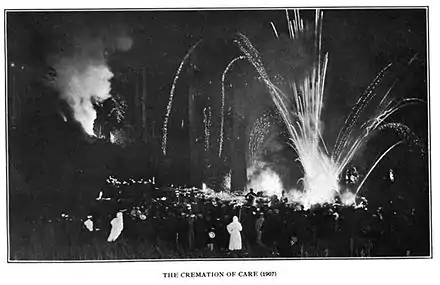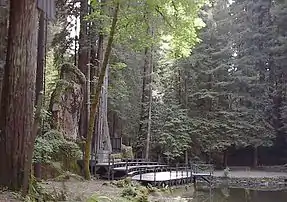Cremation of Care
The Cremation of Care is an annual ritual production written, produced, and performed by and for members of the Bohemian Club and staged at the Bohemian Grove near Monte Rio, California at a small artificial lake amid a private old-growth grove of Redwood trees.

The dramatic performance is presented on the first night of the annual encampment[1] as an allegorical banishing of worldly cares for the club members and "to present symbolically the salvation of the trees by the club",[2] but the secretive nature of the Bohemians and the political power of some of its members have been criticized.
History
In 1878, the Bohemian Club of San Francisco first took to the woods in Taylorville, California (present-day Samuel P. Taylor State Park) for a summer celebration that they called Midsummer High Jinks.[3] Poems were recited, songs were sung, and dramatic readings were given; the practice was repeated each summer in other areas, primarily near the Russian River in Sonoma County. In 1881, the ceremony of the Cremation of Care was first conducted after the various individual performances, with James F. Bowman as Sire.[4] The ceremony was further expanded in 1893 by a member named Joseph D. Redding,[5] with a Midsummer High Jinks entitled The Sacrifice in the Forest, or simply "Druid Jinks", in which brotherly love and Christianity battled and won against paganism, converting the druids away from bloody sacrifice.[6] Redding formed the framework of the ceremony but the main actors, including George Tisdale Bromley as High Priest, were asked to supply their own major speeches.[6] In 1904, the prologue to William Henry Irwin's Grove Play The Hamadryads included text such as "Touch their world-blind eyes with fairy unguents." The play depicted the intrusion, the battles, and the symbolic death of the maleficent Spirit of Care.[7]
In the earliest productions of the Grove Play, several restrictions were imposed upon the Sire (host, chief planner, and master of ceremonies[8]) including that the stage setting be the natural forest backdrop and that the "malign character Care" be introduced in the plot, to wreak havoc with the characters and then be faced down and vanquished by the hero.[2] In these early productions, the Cremation of Care immediately followed, and lasted until midnight.[9] The end of the ceremony was signaled by a lively Jinks Band rendition of There'll Be a Hot Time in the Old Town Tonight,[10] and the club members sat down to a late dinner and revelry.[11]
From 1913, the Cremation of Care was disengaged from the Grove Play, and rescheduled for the first night of the summer encampment.[1] The Grove Play was set for the final weekend.[1] A different Sire was appointed for the Cremation, and some concerns were raised in subsequent years that the Cremation of Care was growing into its own secondary Grove Play. Some Sires experimented with a satirical treatment, or topical themes such as a patriotic World War I treatment in 1918 and an unpopular Prohibition script in 1919. "Care" was not killed, let alone cremated, in the 1922 version. In response to member complaints about the unpredictable quality of the opening night fare, Charles K. Field was asked in 1923 to standardize the script for what became the basis for every subsequent Cremation of Care ceremony.[12]
Staging

The ceremony involves the poling across a lake of a small boat containing an effigy of Care (called "Dull Care"). Dark, hooded figures receive from the ferryman the effigy which is placed on an altar, and, at the end of the ceremony, set on fire. This "cremation" symbolizes that members are banishing the "dull cares" of conscience.[13] At the time the script was developed, the primary meaning of the word 'care' (< O.E. cearu, "anxiety, anguish") was synonymous with 'worry', having more negative connotations than in modern times when it tends to be associated more positively with compassion.[14]
The ceremony takes place in front of the Owl Shrine, a 40-foot (12 m) hollow owl statue made of concrete over steel supports. The moss- and lichen-covered statue simulates a natural rock formation, yet holds electrical and audio equipment within it. During the ceremony, a recording is used as the voice of The Owl. For many years the recorded voice was club guest Walter Cronkite.[15] Music and pyrotechnics accompany the ritual for dramatic effect.[16][17][18][19]
Controversy
On July 15, 2000, Alex Jones and his cameraman, Mike Hanson, infiltrated the Bohemian Grove expecting to uncover the owl statue being worshipped as Moloch, as well as to find simulated human sacrifices by having the effigy of humans thrown into its fiery interior.[20][21][22][23] He also states that they might actually be real human sacrifices.[24] With a hidden camera, Jones and Hanson filmed the Cremation of Care ceremony. The footage was the centerpiece of Jones' documentary Dark Secrets: Inside Bohemian Grove. Jones claimed that the Cremation of Care was an "ancient Canaanite, Luciferian, Babylon mystery religion ceremony". The Grove and Jones' investigation were covered by Jon Ronson in Channel 4's four-part documentary Secret Rulers of the World. Ronson documented his view of the ritual in his book Them: Adventures with Extremists, writing: "My lasting impression was of an all-pervading sense of immaturity: the Elvis impersonators, the pseudo-pagan spooky rituals, the heavy drinking. These people might have reached the apex of their professions but emotionally they seemed trapped in their college years."[25]
Protests
Outside of the main entrance to the Bohemian Grove, protesters against club members and their guests have held a ceremony called the "Resurrection of Care", intended to symbolically reverse the effects of the Cremation of Care, to prevent the attendees from temporarily abandoning their cares.[15] The counter ceremony was first held in 1980, organized by Mary Moore, a former beauty queen turned left-wing activist. Moore was less concerned about the Cremation of Care ceremony than with the likelihood that club members with corporate interests would gain influence in government.[26]
References
- Notes
- Garnett, 1908, p. 36.
- Garnett, 1908, p. 25.
- Garnett, 1908, p. ix.
- Garnett, 1908, pp. 19–20.
- Domhoff, 1974.
- Garnett, 1908, p. 21.
- Garnett, 1908, pp. 4–5.
- Garnett, 1908, p. 17.
- Garnett, 1908, p. 27.
- Ogden, 1990, p. 25.
- Garnett, 1908, p. 30.
- Garnett, 1908, pp. 37–39.
- Phillips, 1994.
- "History of the Notion of Care", Encyclopedia of Bioethics (1995)
- Philip Weiss, Masters of the Universe Go to Camp: Inside the Bohemian Grove. Spy Magazine, November 1989
- George Grove; Waldo Selden Pratt; Charles Newell Boyd, eds. (1920). Grove's Dictionary of Music and Musicians. 6. Macmillan. p. 136.
- Miller, Leta E. (2011). Music and Politics in San Francisco: From the 1906 Quake to the Second World War. University of California Press. p. 38. ISBN 9780520268913.
- Wert, Hal Elliott (2005). Hoover The Fishing President: Portrait of the Private Man and His Life Outdoors. Stackpole Books. p. 108. ISBN 9780811700993.
- Buck, Richard P.; Bethards, Jack M. (2005). Music and Musicians in Bohemia: The First One Hundred Years – a Research Document. Bohemian Club. p. 389.
- Jones, Alex. Dark Secrets: Inside Bohemian Grove. 2000.
- "Bohemian Grove - Alex Jones Timestamp 36:00".
- "Bohemian Grove - Alex Jones - Timestamp 34:38".
- "Bohemian Grove - Alex Jones - Timestamp 38:51".
- "Bohemian Grove 'Human Sacrifice Ritual" Alex Jones Infowars".
- Ronson, Jon (2002). Them: Adventures with Extremists. Simon and Schuster. p. 321. ISBN 0-7432-3321-2. Retrieved 2010-04-18.
- Barry, Dan (July 27, 2010). "Redwoods Hideaway for the Elite Goes On, but Protest Days Fade". The New York Times. Retrieved June 29, 2011.
- Bibliography
- Bohemian Club. Cremation of Care, Bohemian Club Grove, 1914
- Bohemian Club. Ceremony of the Cremation of Care, July 27, 1918
- Bohemian Club. History, officers and committees, incorporation, constitution, by-laws and rules, former officers, members, in memoriam, 1960
- Bohemian Club. History, officers and committees, incorporation, constitution, by-laws and rules, former officers, members, in memoriam, 1962
- Bromley, George T.; Frederick Somers; Bohemian Club. The Cremation of Care Fifty-third Celebration, 1933
- Domhoff, G. William, The Bohemian Grove and Other Retreats: A study in ruling class cohesiveness, Harper and Row, 1974.
- Field, Charles Kellogg; Bohemian Club. The Cremation of Care. "On the Occasion of the Sixty-seventh Consecutive Performance of the Cremation of Care, the Ritual Now in Use is Published by the Club for Its Members with the Introductory Review of the Evolution of the Ceremonial." 1947
- Field, Palmer; Bohemian Club. The Cremation of Care: A History Exhumed and Dusted Off by Palmer Field. "Upon the Occasion of the 74th Consecutive Performance, July 18, 1953"
- Garnett, Porter, The Bohemian Jinks: A Treatise, 1908
- Keeler, Charles Augustus; Wade C Hughan; Karen Melcher (frontispiece); Peter Rutledge Koch. A Service for the Cremation of Care, Lands End Press, 1989
- Newhall, Almer M.; Bohemian Club. The Ceremony of the Cremation of Care, 1920
- Ogden, Dunbar H.; Douglas McDermott; Robert Károly Sarlós (1990). Theatre West: Image and Impact. Rodopi. ISBN 90-5183-125-0.
- Phillips, Peter Martin. A Relative Advantage: Sociology of the San Francisco Bohemian Club, 1994.
- Swinnerton, James G.; Bohemian Club. The Cremation of Care. "Fiftieth anniversary of the cremation of care." 1930
